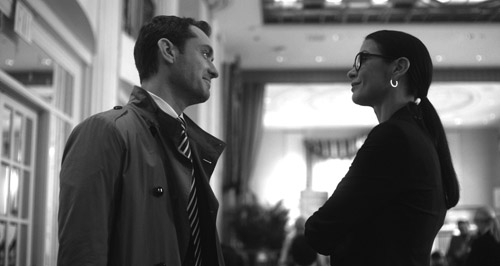Steven Soderburgh’s new film is A Tough Pill to Swallow

Gina Scialabba
The Guardsman
A woman claims prescription drugs drives her to kill.
That’s the plot of Steven Soderbergh’s latest and reportedly last film.
It begins with a clear vision—a noir Hithcockesque “whodunit.”
This movie has all the elements of a solid, clever picture. The heavyweight cast includes Jude Law, Rooney Mara (“The Girl with the Dragon Tattoo”), Channing Tatum, (yes, the stripper from “Magic Mike,” also a Soderburgh movie) and Catherine Zeta-Jones.
Yet, what audiences think will be an intelligent critique of the pharmaceutical industry suddenly goes off into a different orbit about 30 minutes into the film.
We are left with an unfocused, predictable, eye-rolling thriller bordering on preposterous.
Note: Reviewing a murder mystery is a delicate balance of not giving away too much, but just enough. I’ll try to restrain myself.
It begins with familiar foreshadowing. Someone has done something bad. Very bad. A murder. Blood. A weapon.
All that’s missing is the candlestick, the lead pipe and Colonel Mustard and Mrs. Peacock.
The who, what, where, how and why are largely unknown, but as the movie unfolded I became optimistic, and intrigued by the possibility that this would become a classic “whodunit.”
Enter Emily (Mara), a wife anxiously awaiting her husband’s (Tatum) return from a four-year prison sentence. He’s locked up for insider trading. She is depressed.
So the story goes …
Enter Dr. Banks (Jude Law), a dashing doctor in a white lab coat and winning smile. He’s treating Emily after her first “suicide” attempt.
Yes, “suicide” is in quotes for a reason.
Enter “Ablixa,” a fictitious antidepressant which is supposedly the culprit of all this havoc.
How can this small little wonder pill be the center of all the conflict? That’s the point. It’s ultimately not.
As Soderburgh takes audiences deeper and deeper down the rabbit hole, the movie becomes less about Ablixa and more about shock value.
One in 10 Americans report suffering from some level of depression in this country, according to the Centers for Disease Control.
Many live in a “a gray fog of hopelessness,” as Emily describes her symptoms. Depression is serious business.
Not every movie has to be an indictment of some social ill, but Soderbergh treating mental illness as a red herring is a rip-off.
The potential to create a dialogue about the serious problems between patient care and the incentives provided to doctors by pharmaceutical companies is completely glossed over.
Suddenly, the movie becomes a litany of hat tricks all stemming from greed and lust, forgetting the bigger picture.
Oh, and Soderbergh certainly didn’t pass up his chance to jump on the all-too- familiar, gratuitous lesbian-kiss scene.
Enter Catherine Zeta-Zones, Emily’s former therapist.
While the plot as a whole borders on laughable, the performances are standout.
Rooney’s monotone, brooding demeanor is luminous and completely convincing. Her portrayal of a woman’s spiraling emotional breakdown is excellent.
It is hard to ever be disappointed by a Jude Law performance. He plays the British, French-speaking, fashionably-dressed doctor fighting for his life and career.
I wish I could say the same for Channing Tatum. His acting is consistently hollow and cardboard.
Despite some standout performances, this movie ends up being a tough pill to swallow.

Comments are closed.